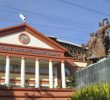There are three pictures on the Philippine Daily Inquirer�s front page for March 17, 2007 that present an interesting insight on the state of the nation.
BY JPAUL MANZANILLA*
Contributed to Bulatlat
There are three pictures on the Philippine Daily Inquirer�s front page for March 17, 2007 that present an interesting insight on the state of the nation.
On the upper half of the page, the largest photo, is Satur Ocampo, arrested at the Supreme Court. The Bayan Muna party-list representative reappeared in public eyes to face the murder charges filed against him by the Armed Forces of the Philippines (AFP).
On the lower left corner of the daily�s cover is U.S. Ambassador Kristie Kenney playing dama (Pinoy chess) with a Legazpi City resident. According to the caption, the U.S. envoy �(inspected) the weeklong humanitarian mission dubbed �Goodwill-Kaibigan� being conducted by American Marines in cooperation with the Armed Forces of the Philippines.�
Just on the right side of the Kenney photo is Ramon Magsaysay, third president of the postwar republic, in a leaping position. The picture caps Sen. Ramon Magsaysay Jr.�s remembrance of the original Magsaysay�s 50th death anniversary, in time for a self-reflective gesture on his last year as senator.
One photo reinserts the past into the present, the other two photos battle to win the present for the nation�s future. What do these three photographs show?
Following American art historian WJT Mitchell�s call to go beyond knowing the meaning of images, we ask: �what do these pictures want?�
Three personalities
Ocampo, the present margin of Philippine political realities, was a journalist who became an activist owing to a responsibility to the truth he was reporting. He had been arrested three times. The first was in 1976 when militants were usually abducted and made to disappear under martial rule. Second was in the post-Marcos �liberal democratic� but actually low intensity conflict-total war Aquino regime. As of this writing, he was released on bail and is fighting to win the trumped-up charge of masterminding the killing of suspected government spies in the communist movement he is accused of having been leading.
Kenney, of course, is the pretty face of U.S. business in the neocolony. The more aggressive photo opportunities, the more hectic is direct intervention in our country�s sovereign affairs. Kenney is in the here, there and everywhere of military exercises, disaster relief operations, medical mission, education programs, and recently, extrajudicial killings. Our business is her business, and the photos of humanitarian work all over the country are not a mask of the brutal realities implicating U.S. imperialism but a necessary face of it.
Magsaysay Sr. is a politician packaged to win social acceptance. The resurgence of the Hukbong Mapagpalaya ng Bayan in the early 1950s forced the U.S.-directed government to focus on the importance of public relations work in counterinsurgency campaign. Thus, the former defense secretary and prot�g� of Central Intelligence Agency (CIA) operative Edward Lansdale was pictured to be seen-and documented to be immortalized-as the leader who always talked with the common tao, participated in livelihood projects, opened government offices to the poor, and fired erring officials. Murderous rampage was coupled with humanizing the image.
Who will win the hearts and minds of the people?
One narrative structure
Interestingly, the three photos triangulate the desire discussed by Mitchell as the central question of images: from What do pictures mean? to What do pictures want? Crucially in his discussion, there is a shift from power (doing) to desire (wanting). While it is far from certain whether such a proposal to �scale down the rhetoric of the �power of images�� possesses a strategic benefit, it will be beneficial for us to analyze �what it is they lack, what they do not possess, what cannot be attributed to them.� For more than presenting an ocular inspection of the forces and interests that contend over the nation, the three front-page photos of the Inquirer symptomatize the state of emergency the country has been under as a rule for the longest time. The basic point is that the mass media of newspapers and Internet publication function here as a mode that produces perception of the current coordinates of social power. In particular, it actively engages in the production of meanings by compelling our sense of sight to attend to its own theory of Philippine politics.
It is important to note that Magsaysay Jr. expressed his belief that �those who cannot remember the past are condemned to repeat it.� His article lists the son�s credentials as a continuity of the father�s achievements. He avowed that remembering and not repeating the mistakes of the past �is the true roadmap for the leader who wants to regain the people�s confidence in their government.� Memory is accordingly the basic element to understand the past. In the language of the national democratic movement, this same bureaucrat capitalist tries to repair the damage wrought by rioting factions of the controlling elite, vying for American support while waging a total war against the people.
Because here we are again, at a time when successive governments are on the brink of being toppled, the ruling class is sounded a reform. That whenever they cannot remodel themselves, the people�s progressive movement is sure to win the people�s hearts and minds. Our photo of the U.S. ambassador playing chess with a Filipino, figuring out the right moves that will �checkmate� the native, testifies to the continuing intervention, projected as a kind of play, of an imperialist superpower in our country�s affairs. She then provides the interplay between two antagonistic forces in Philippine politics, one progressive and revolutionary and another trapo and counterrevolutionary, on who will acquire the legitimacy to govern this country. To their minds, there should be no alternative to the present system but a reform that will perpetuate the old.
Lastly, the contrasting positions of Magsaysay and Ocampo visualize the class struggle of a chronic crisis that is Philippine society. Magsaysay is leaping to greatness (like a leap for Filipino humankind) as though to conquer the force that is Ocampo, being arrested by police forces from the judiciary hall of the Supreme Court to the executive office of the Western Police District. This seize of Ocampo parallels the state of siege by which the oppressive ruling order manages to block the emergence of an alternative order out to end the people�s suffering. In a sense, this seizure characteristic of a nervous system nearing its breakdown exhibits the seizure of political power undertaken by democratic forces long denied their picture of reality.
The resolution of this picture, as one of the many climax points in the narrative of civil (people�s) war, depends on the realization of the desires of the toiling Filipino masses for sovereignty, freedom, justice, and democracy.
The photo that will personify such desire is still being shot. Contributed to Bulatlat
Reference
Mitchell, W.J.T. What Do Pictures Want?: The Lives and Loves of Images. Chicago and London: University of Chicago Press, 2005. 28-56.
Editor�s Note: JPaul Manzanilla is research and education head of the Amado V. Hernandez Resource Center (AVHRC). He served as University of the Philippines (UP) Center for Nationalist Studies chair, Student Alliance for the Advancement of Democratic Rights in UP (Stand UP) spokesperson, and Katipunan ng mga Sangguniang Mag-aaral sa UP secretary-general at various times. He now teaches at the Department of Arts and Communications of UP Manila.










